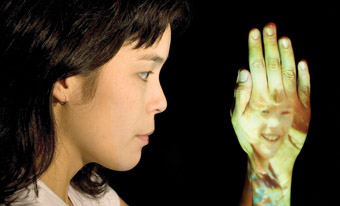 |
Adrienne Wong, My Name is Rachel Corrie photo Tim Matheson |
The Havana is a small black box theatre located at the back of a restaurant on Vancouver’s eastside. It has never looked so gorgeous. The space has been completely cleared, with a single row of seating running around the four walls. Above the seating are wall-length rectangular projections. When the audience enters, cuttings from newspapers telling of Corrie’s death are projected. The texts overlap making them difficult to read. During the show, the projections are mostly colours and abstract designs until Corrie arrives in the Middle East, at which time we see photos of cityscapes and destruction. In the centre of the space a white square is boldly defined on the black floor. Within the square there is an office chair and an indefinable piece of ugly office furniture which acts as a table. The space looks futuristic and very tidy. Resting on the table is a white Mac Book computer, a model unavailable in 2003 when Corrie was killed; an early clue to the distancing artifice that informs the production.
The performer, Adrienne Wong, greets the audience as they come in, introducing herself to strangers. If she knows you, she greets you by name and spends a few moments catching up. When the show is ready to start, Wong goes to the entrance, where two more Mac Books glow stylishly in the darkness. She closes the door and does something with the laptops, giving the impression that she’s running the show with them. She makes her way to the performance space, takes off her shoes and then – accompanied by a suitable jet-like sound and lighting effect – steps onto the white square. She never leaves this claustrophobic space, except for one stylized moment where she follows a lighted path around the square. The rest of the time, Wong moves restlessly around the space engaging with the audience, making direct eye-contact.
It’s worth describing the production in this much detail. I will long remember the stylish presentation but not, alas, Corrie’s words. This is a production interested in the artifice of performance. The implication is that we should never believe Wong is Corrie and I never did. Rather, she is Wong performing Corrie’s words. Perhaps the producers, neworld and Teesri Duniya Theatre, were concerned about mimicry and felt this was a more sensitive approach to remembering Corrie. Unfortunately for me the artifice was simply too heavy. Wong’s entrapment within the white square is too distracting, even the projections take us too far from the words. This is not a traditional script with a coherent narrative structure that can support all the weight the production throws upon it. It is too fragile.
Wong is a charismatic performer who commands attention but even she struggles against the artifice. She gallops restlessly through the script at high speed. Perhaps this is meant to evoke Corrie’s youthful energy but it came across to me as a lack of faith in the material. It meant that her performance wasn’t as nuanced as it should have been and came off as too one-note. The one moment where things did slow down – an e-mail exchange between Corrie and her father – suddenly brought the production to life.
Corrie was a list maker and lists are featured repeatedly throughout the text. List-makers try to impose some form of order on a chaotic world. It is ironic that the over-determined nature of this production overwhelms Corrie. Her writings demonstrate the passion and emotion that drove her, yet this production generates a cool, intellectual distance. Perhaps this was a response to the controversy that has dogged this play (protests took place in New York and Toronto over the play’s sympathetic depiction of the Palestinians). While rationalism is laudable in the face of polarised debate, it seems untrue about what we know of Corrie. With the audience able to see each other, with Wong making direct eye-contact there is a form of calculated intimacy but it was with the performer and not the text or with Corrie herself.
Rachel Corrie was a vibrant individual seeking a role in the world and an identity that would suit her passions. Despite her strengths, her fragile body was too easily destroyed. I wish this production had relaxed its intellectual guard so that we could glimpse more of the fragile beauty of the script and the emotional power of Rachel’s story.
neworldtheatre & Teesri Duniya Theatre, My Name is Rachel Corrie, taken from the writings of Rachel Corrie edited by Alan Rickman and Katherine Viner, director Sarah Garton Stanley, performer Adrienne Wong, collaborating director Marcus Youssef, designer Ana Cappelluto, lighting Itai Erdal, sound Peter Cerone, video Candelario Andrade, sound/video systems Jesse Ash; Havana Theatre, Jan 24-Feb 2; PuSh International Festival of Performing Arts, Jan 16 - Feb 3
Andrew Templeton is Vancouver-based writer and playwright who's had plays produced in Vancouver and London.
© Andrew Templeton; for permission to reproduce apply to [email protected]








 back
back